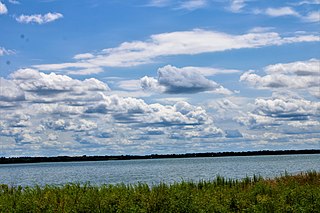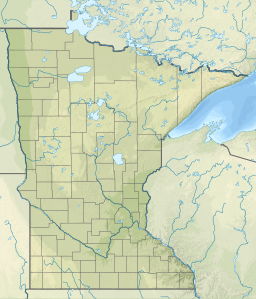
The Sauk or Sac are Native Americans and Indigenous peoples of the Northeastern Woodlands. Their historical territory was near Green Bay, Wisconsin. Today they have three tribes based in Iowa, Kansas, Nebraska, and Oklahoma. Their federally recognized tribes are:
Gordon Township is a township in Todd County, Minnesota, United States. The population was 545 at the 2000 census and 659 in the 2020 census.
Kandota Township is a township in Todd County, Minnesota, United States. The population was 679 at the 2000 census and in the 2020 census it was 805.
Leslie Township is a township in the southwestern corner Todd County, Minnesota, United States. The population was 668 at the 2020 census.
Round Prairie Township is a township in Todd County, Minnesota, United States. The population was 692 at the 2000 census. By the 2020 census the population had increased to 714 residents.
Turtle Creek Township is a township in Todd County, Minnesota, United States. The population was 323 at the 2000 census and was 270 at the time of the 2020 census.
Ward Township is a township in Todd County, Minnesota, United States. The population was 471 at the 2000 census and 474 at the 2020 census.

Sauk Centre is a city in Stearns County, Minnesota, United States. The population was 4,555 at the 2020 census. Sauk Centre is part of the St. Cloud Metropolitan Statistical Area.
Bruce Township is a township in Todd County, Minnesota, United States. The population was 564 at the 2000 census but had declined to 479 by the 2020 census.

Leech Lake is a lake located in north central Minnesota, United States. It is southeast of Bemidji, located mainly within the Leech Lake Indian Reservation, and completely within the Chippewa National Forest. It is used as a reservoir. The lake is the third largest in Minnesota, covering 102,947.83 acres (416.6151 km2) with 195 miles (314 km) of shoreline and has a maximum depth of 156 feet (48 m).
Okamanpeedan Lake, partially located in Martin County, Minnesota, and Emmet County, Iowa, is also known as Tuttle Lake. Okamanpeedan Lake is a roughly 2,300-acre (9.3 km2) riverine lake located on the East Fork of the Des Moines River. It has an average depth of about four to six feet. The lake has a contributing watershed of approximately 120,056 acres (486 km2) and watershed:lake ratio on the order of about 50:1. The lake is situated in a glacial till plain and is generally in an area dominated by loamy, poorly drained soils. The area is primarily level but does have some rolling hills.

The Sauk River is a 122-mile-long (196 km) tributary of the Mississippi River in central Minnesota in the United States. It drains small lakes in Stearns County. In the Ojibwe language it is called Ozaagi-ziibi, meaning "River of the Sauks".
Lake Hook, sometimes referred to as Hook Lake, is a 330 square acre lake in McLeod County, in the U.S. state of Minnesota, that is a popular fishing destination. The lake is approximately 18 feet at its deepest point with an average depth of 8 feet and a shoreline spanning 4 miles.

The Long Prairie River is a tributary of the Crow Wing River, 96 miles (154 km) long, in central Minnesota in the United States. Via the Crow Wing River, it is part of the watershed of the Mississippi River, draining an area of 892 square miles (2,310 km2) in a generally rural region.

Christina Lake is a lake situated in west-central Minnesota. It is primarily situated in Douglas County, with its western part extending into Grant County. The lake measures 3,978 acres (16.10 km2), with an average depth of 4 ft (1.2 m). The lake is a designated Wildlife Management Lake and is nationally recognized for providing a staging area for migrating waterfowl, particularly the canvasback. Literally tens-of-thousands of waterfowl can be seen clustered in huge rafts across the expanse of the lake during peak migration, making the spot a primary destination for birders and waterfowlers.
Libby is an unincorporated community in Libby Township, Aitkin County, Minnesota, United States. The community is located between McGregor and Jacobson along State Highway 65. The Mississippi River flows nearby. Libby is located immediately northwest of Big Sandy Lake.
Green Lake is a lake in Chisago City, Minnesota, United States. This lake is sometimes also referred to as "Big Green Lake" because it is connected to Little Green Lake by a channel. Green Lake was named from the fact its waters are green from the high algae content.

Amelia Lake is a lake in Pope County, Minnesota, the United States, located 6.7 miles away from Glenwood. Amelia lake has an elevation of around 1,348 feet (411 m). The lake sits on a lot of 910 acres. The depth of Amelia Lake is 69 feet (21 m) and water clarity can approach 12 feet (3.7 m) during the summer. This lake is open to the public to fish with a proper fishing license.
Lake Ann is a lake in Carver County, Minnesota, in the United States.
Serpent Lake is a lake in Crosby and Deerwood, Crow Wing County, in the U.S. state of Minnesota spanning 1,103 acres. Fish that swim there include: Black Bullhead, Bluegill, Brown Bullhead, Largemouth Bass, Northern Pike, Pumpkinseed, Rock Bass, Smallmouth Bass, Walleye, Yellow Bullhead and Yellow Perch. Serpent Lake is an English translation of the Ojibwe language name.








